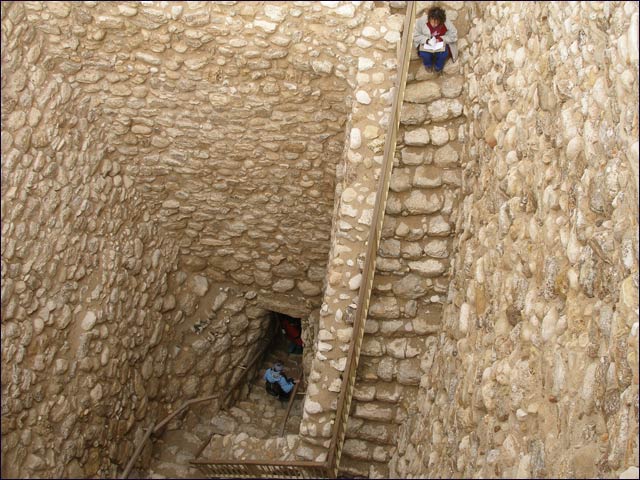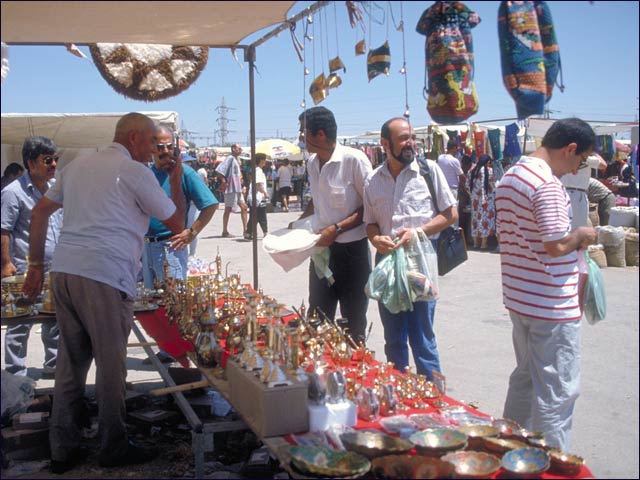By Avigayil Kadesh
Beersheva has come a long way from the days when the patriarch Abraham dug the well that gave the city its name about 3,700 years ago.
Though you can still see Abraham’s Well – or at least the tourist spot that commemorates the biblical story – today there is much more than miles of sand to explore in the unofficial capital of the Negev Desert, located in the heart of Israel about a 90-minute drive from Jerusalem and less
than an hour from the Dead Sea.
The city’s name, also spelled Be’er Sheva or Beersheba, means Well of the Oath because it was here that Abraham swore an allegiance of peace with Abimelech, the local king in those days. Abraham’s descendents, Jews and Muslims both, populate the modern city and its surroundings. Added to that mix are newer arrivals of Sudanese, Ethiopian and Russian heritage bringing the number of residents to about 195,000.

Entrance to biblical water system unearthed in Tel Sheva.
Photo courtesy of Israel Tourism Ministry
In fact, one of the most striking aspects of 21st century Beersheva is the confluence of varying ethnicities of Jews and (mostly Bedouin) Arabs in the corridors of its institutions and public spaces, from the renowned Soroka Medical Center to the academically respected Ben-Gurion University of the Negev (BGU); from the traditional marketplaces to the spanking new shopping malls and hiking trails – most notably, the Round Be’er Sheva Trail that won third prize from the European Ramblers Association in its 2012 ECO-Award competition.
Ben-Gurion University of the Negev.
Photo courtesy of Israel Tourism Ministry
In the past year, the municipality has been working towards upgrading the tourism infrastructure and branding Beersheva as Israel’s “Water City,” with the installation of public fountains and even a manmade beach on the drawing board.
On top of all that, a thriving nightlife is growing amidst this cultural hodge-podge. In Beersheva you’ll find The Forum, the biggest nightclub in Israel, taking its place among upscale restaurants, coffee shops and pubs.
Ringelblum Street, just outside the BGU campus, has become a national example of how students can affect social justice and environmental responsibility in the workplace. Restaurants and businesses on this trendy strip can earn a free “Community Covenant” (Tav Chevrati in Hebrew) seal of approval in return for their pledge to respect employees’ legal rights, practice environmental responsibility and provide accessibility to people with disabilities. Regularly scheduled street festivals add to the youthful fun on Ringelblum.
Entering Beersheva through its art
British native Hannah Rendell last year founded the Be’er Sheva Art Experience (B7), aimed at getting more tourists into Beersheva and especially into its Old City area, which has seen a recent infusion of $10.5 million in renovations. “Like any developing city, we need tourists to come and show interest to get things moving,” she says.
Rendell has been living in the city with her husband and two children for four years, and feels frustrated that Beersheva is not on most foreign visitors’ radar, despite a new tourist and information center opened in 2009.
“Currently, Beersheva doesn’t have much tourism,” she says. “It’s seen mainly as a stopover to Eilat. Because there isn’t a lot available in English about Beersheva, travelers have a misconception that there isn’t enough to do here, but there is.”
B7 is working with the municipality to entice tourists to the
Negev Museum of Art and private art galleries, by offering one- and two-day workshops and tours for groups coming to Israel, and by encouraging the municipality to post English-language signage at tourist sites.
“We link it with the art experience because we believe art is the best way to show people the city and to help the city grow and develop,” says Rendell, a sculptor. In the past year, B7 has brought about 1,000 people to Beersheva.
The Negev Museum of Art is situated in what used to be the home of the Ottoman governor. It was built in 1906 next door to a mosque that now serves as an exhibition space. During the British mandate, the structure was taken over by a girls' school and then became the city hall after 1948.
An extensive renovation in 2004 brought the preserved historic building up to modern standards. The museum today contains two galleries, a grand entrance yard, and a performance area for live concerts during the summer. Guided tours are available every Wednesday at 5 pm and Saturday at 11 am.
B7’s most popular workshop is the Photography Trail, where a professional photographer takes groups around the Old City and gives pointers on taking the best shots. But Rendell has many other suggestions as well.
“For a day of activities, I’d recommend to start by walking around the Old City and looking at its buildings. Beersheva is the only city that the Ottomans built, and many of the original buildings are still intact. The Old Mosque right now has an exhibition about Australians who helped liberate Beersheva during World War I. There is a memorial for soldiers -- the Beersheva Negev Brigade Monument -- that is really beautiful. And there is the old Turkish train station, built in 1915.”
There is more for English-speakers, too.
Annual musicals are staged in English by the
Light Opera Group of the Negev, established in 1980. Its 2013 production is “Beauty and the Beast,” scheduled to run in February and March. There are also regular classical music concerts offered by the
Israel Sinfonietta of Beersheva, which is sponsoring its first Beethoven marathon in December.
Ring around Beersheva
As part of its Blueprint Negev project, Keren Kayemeth LeIsrael-Jewish National Fund (KKL-JNF) is completing the final stages of the
Beersheba River Walk.
This 900-acre site, when finished, will include hiking and biking trails, a botanical garden based on desert flora, a sports arena and amphitheater, a boating lake filled with purified wastewater, promenades and eateries. For many years, wastewater flowed in the channel of the Beersheva River, and its banks were used as a garbage dump. This KKL-JNF restoration project has transformed the area into a green oasis on both sides of the riverbank.
Another place to view wildlife is at the Zoological Garden of Beersheva (otherwise known as the Negev Zoo), established in 1954 as a small petting zoo and now expanded to include a large collection of mammals, birds and reptiles.
The newly opened Round Be’er Sheva Trail (RBST), which will be expanded in coming months and years and will eventually meet up with the
Israel National Trail, is Israel’s only city-encompassing path.
Planned out and marked in 2008 by the Israel Trail Committee and dedicated by Beersheva Mayor Ruvik Danilovich in 2012, the RBST’s unusual urban-environmental model is what earned it the ECO-Award.
Built cooperatively by the municipality, the Israel Nature and Parks Service, the Jewish National Fund, the Antiquities Authority and the Society for the Protection of Nature in Israel, the RSBT brings walkers and cyclists past the Negev Brigade Monument, the Zoological Garden, the Beersheva River and the Beit Eshel historical site, as well as the UNESCO World Heritage Site
Tel Beer Sheva National Park.
Delving into prehistory and modern ecology
Three miles east of present-day Beersheva, Tel Beer Sheva is the area archeologists identify with the biblical city.
The site includes ruins going back to the fourth millennium BCE. Evidence was uncovered of a walled city from the Israelite monarchic period in the Iron Age, and traces of settlement from the Roman era during which the borders began spreading to the area of today’s city. It was an important fortress as it lay along the well-traveled route from Egypt to the Dead Sea. Tel Beer Sheva also has early churches and once served as the bishop’s residence.
Tel Beer Sheva’s first Israelite inhabitants engineered a meticulous waterworks whose centerpiece is a huge tiled shaft dug 50 feet underground into a large reservoir fed by Hebron River floodwaters. Also discovered here was a 230-foot well, the deepest water well ever found in Israel.
Also just outside Beersheva in the industrial Ramat Hovav area, the
Ramat Hovav Visitor Center gives tourists age 17 and up access to a pollution-monitoring station, where guides explain how the pollution level from the factories’ chimneys is checked, and also describe methods used for purifying and treating wastewater.
Along the same lines of ecology, but with a different focus, Beersheva will soon hold the distinction of housing Israel’s largest – and “greenest” -- shopping mall. Now under construction, the 115,000-square-meter facility will feature pools for collecting rainwater and lighting generated by solar panels on the roof.
Also on the drawing board are an enclosed Farmers Market and a new central bus station that will double as a shopping center.
For an old-time shopping experience, nothing beats the Bedouin market. It’s been open every Thursday since 1905, drawing Bedouin vendors and merchants from the neighboring villages selling copper products, glassware, jewelry, woven crafts and rugs, clothing, footwear, and food.

Beersheva Bedouin Market.
Photo courtesy of Israel Tourism Ministry
At the Center for Ethiopian Craftsmanship, new immigrant women practice the ancient earthenware, embroidering, sculpting and straw handicrafts of their home villages.
B7’s Rendell says Beersheva is a wonderful off-the-beaten-path destination with more and more businesses, parks, archeological and tourist sites opening all the time.
“It’s really important to come here to see the real Israel, where you have so many different kinds of people living life together everyday. I also like showing people outside Israel that there is affordable housing here with a high standard of living, and some cosmopolitan lifestyle. We don’t have a beach yet,” she adds with a smile, “but the mayor is working on it.”